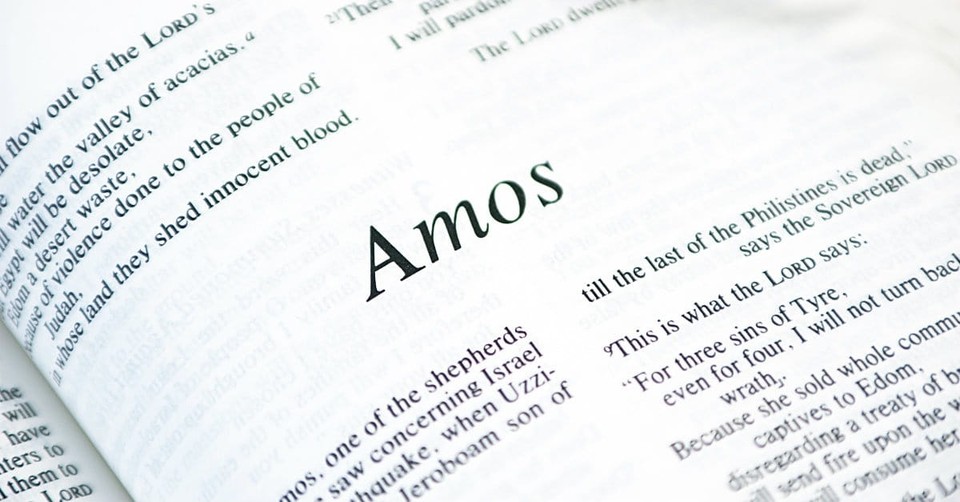4 Ways the Gospel Appears in the Book of Amos

This post is an excerpt from the ESV Gospel Transformation Bible, written by David R. Helm. The following article was taken from Crossway.org; used with permission.
The Gospel in Amos
In four ways, the Old Testament book of Amos is essential for a robust understanding of the gospel.
1. Amos was written with God’s people in mind.
While Amos 1:2–2:3 includes judgments against the nations surrounding Israel, the bulk of the book is directed at Israel (with Judah, the southern kingdom, included). Importantly, the restoration of all the nations called by God’s name in 9:11–15 brings the book full circle, as those once judged are ultimately blessed under a new affiliation.
As such, the audience is both particular and universal. New Testament quotations from Amos refer to both of these groups. When quoted by Stephen in Acts 7, the words of Amos anticipate the covenant family of Israel as the audience. Yet eight chapters later (Acts 15:16–17), James will reference the book of Amos in terms of what God is saying to all the families of the earth (i.e., the Gentiles). Thus, Amos has something to say to ancient Israel as well as to the whole world—even to us.
2. Amos was written with practicality in view.
Christians often quote Amos for its emphasis on social justice, and rightly so. Yet we must learn to handle this emphasis properly. Amos’s condemnation of Israel’s life of luxury and laziness at the expense of the poor should not be treated in a way that reduces the heart of Christianity merely to social ethics. The heart of Christianity is the gospel.
The necessary societal implications of the gospel must not be confused with the gospel itself. Both are crucial; our challenge is to understand how mercy is integral to the Christian’s identity without reducing the entirety of the Christian message to doing acts of mercy. To see the gospel as a call merely to extend mercy to others without rooting this in the gospel’s call to receive God’s mercy toward us as sinners is to lose the gospel itself.
3. The apostles’ use of the concept of place in Amos reveals God’s mission to the world.
Place signifies more than mere geography. Amos uses a variety of terms for place (e.g., house, tent, city) to represent the people’s relational proximity to or distance from God. For Amos, place becomes a way of addressing the people’s orientation toward God as well as God’s orientation toward them. From the opening verses to the book’s closing, God announces and executes a ministry of justice and mercy from particular places: from Zion and Jerusalem (Amos 1:2), and from the altar (9:1). Once we grasp its importance in Amos, the concept of place will help us better understand the book’s message and our mission in the world.
Both times that Amos is directly quoted in the New Testament, the concept of place relating to God’s family is in play. In Acts 7, Stephen uses Amos to vindicate God’s judgment of his household when its members put their own well-being above his kingdom and rule. Later, in Acts 15, James references Amos, and place is again significant. This time, however, the message of Amos is used to validate God’s plan for rebuilding his household from among all the nations of the earth.
4. Amos’s use of poetry reveals the intensity of God’s relationship with the world.
The book is largely a blistering declaration of God’s impending judgment on Israel and the world. In fact, Amos uses a phrase for eschatological (end-time) judgment—“the day of the Lord” (Amos 5:18–20)—that the New Testament repeatedly echoes.
That this judgment is expressed in poetry surprises many readers. And this raises the question: why did God give us Amos in poetic verse rather than in legal arguments? After all, in our day, poetry is often the language of love and not lawsuit. Yet poetic language can also express anger, disdain, or lament. As such, it is the genre best suited to convey the idea of God as a divine warrior, driven on by an emotive sense of justice that is at the same time grounded in love.
David R. Helm (MDiv, Gordon-Conwell Theological Seminary) serves as lead pastor of the Hyde Park congregation of Holy Trinity Church in Chicago. He also serves as chairman of The Charles Simeon Trust, an organization which promotes practical instruction in preaching. He is the coauthor (with Jon Dennis) of The Genesis Factor, a contributor to Preach the Word: Essays on Expository Preaching, and the author of The Big Picture Story Bible and 1–2 Peter and Jude in the Preaching the Word commentary series.
Publication date: October 20, 2016
Image courtesy: Thinkstockphotos.com
Originally published October 20, 2016.







